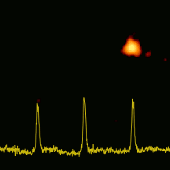ESA Science & Technology - Science Results
Science Results
Science Results
Scientists analysing data from the Cassini mission have found evidence of light, soluble and reactive organic molecules in the ice grains ejected by Saturn's icy moon Enceladus, providing another important piece of evidence to investigate its potential habitability.
Scientists analysing the treasure trove of images taken by ESA's Rosetta mission have turned up more evidence for curious bouncing boulders and dramatic cliff collapses.
For the first time, astronomers have detected synchronised pulses of optical and X-ray radiation from a mysterious pulsar some 4500 light years away. The observations indicate that a new physical mechanism might be needed to explain the behaviour of fast-spinning sources like this one, known as transitional millisecond pulsars.
With data from the NASA/ESA Hubble Space Telescope, water vapour has been detected in the atmosphere of a super-Earth within the habitable zone by University College London (UCL) researchers in a world first.
ESA's X-ray space telescope XMM-Newton has detected never-before-seen periodic flares of X-ray radiation coming from a distant galaxy that could help explain some enigmatic behaviours of active black holes.
Just as people of the same age can vary greatly in appearance and shape, so do collections of stars or stellar aggregates. New observations from the NASA/ESA Hubble Space Telescope suggest that chronological age alone does not tell the complete story when it comes to the evolution of star clusters.
Rather than leaving home young, as expected, stellar 'siblings' prefer to stick together in long-lasting, string-like groups, finds a new study of data from ESA's Gaia spacecraft.
On 31 March 2017, Jupiter's moon Europa passed in front of a background star – a rare event that was captured for the first time by ground-based telescopes thanks to data provided by ESA's Gaia spacecraft.




















